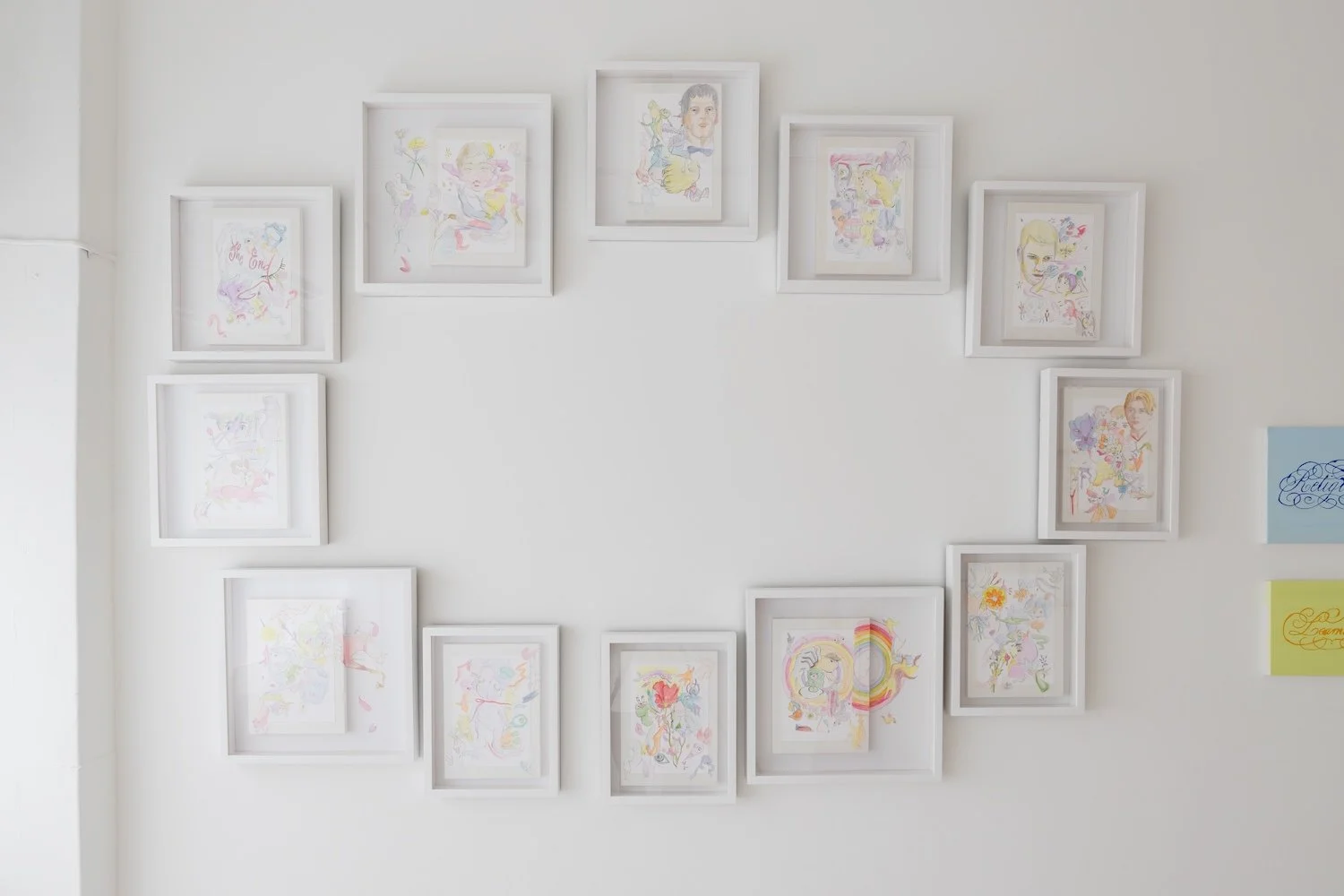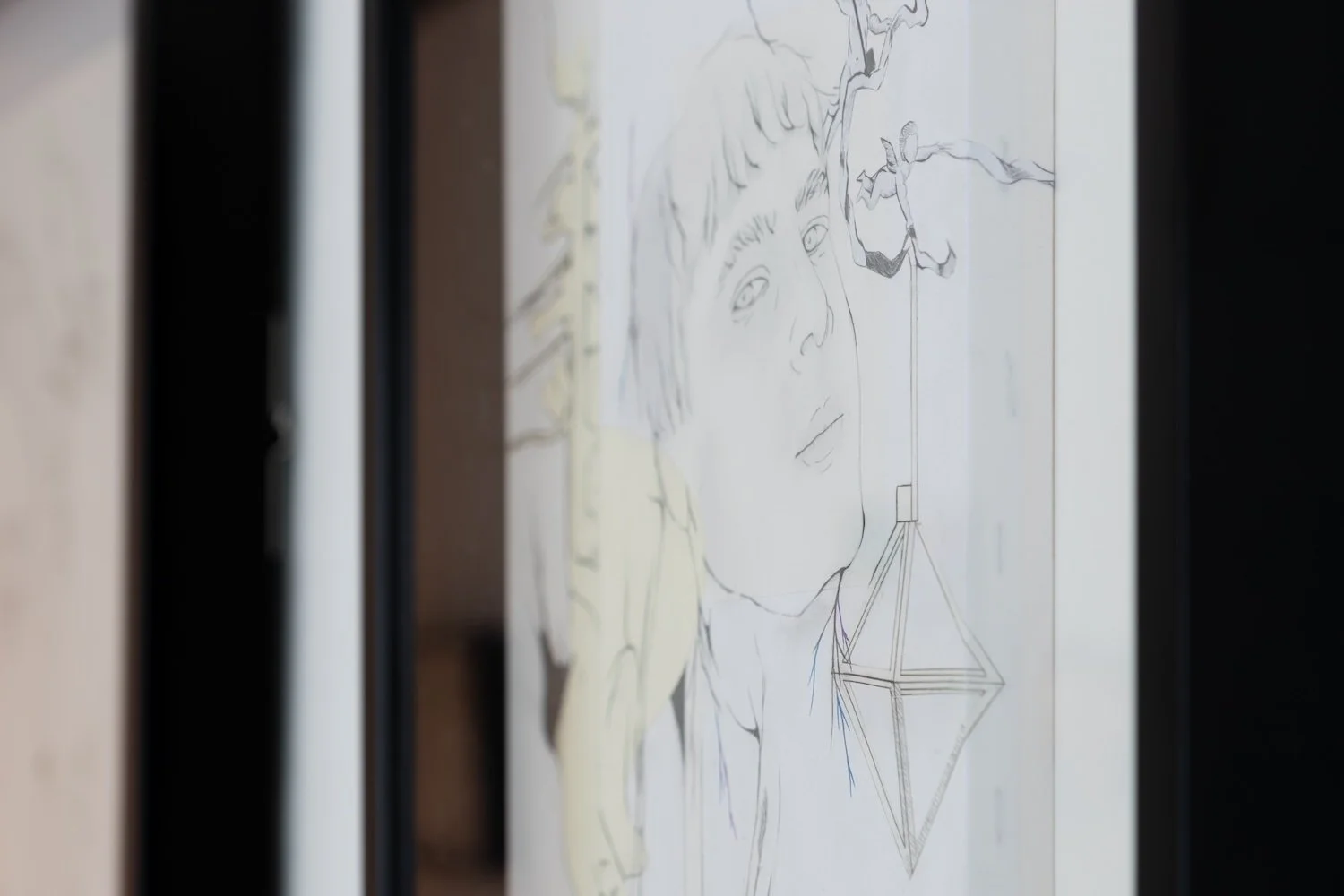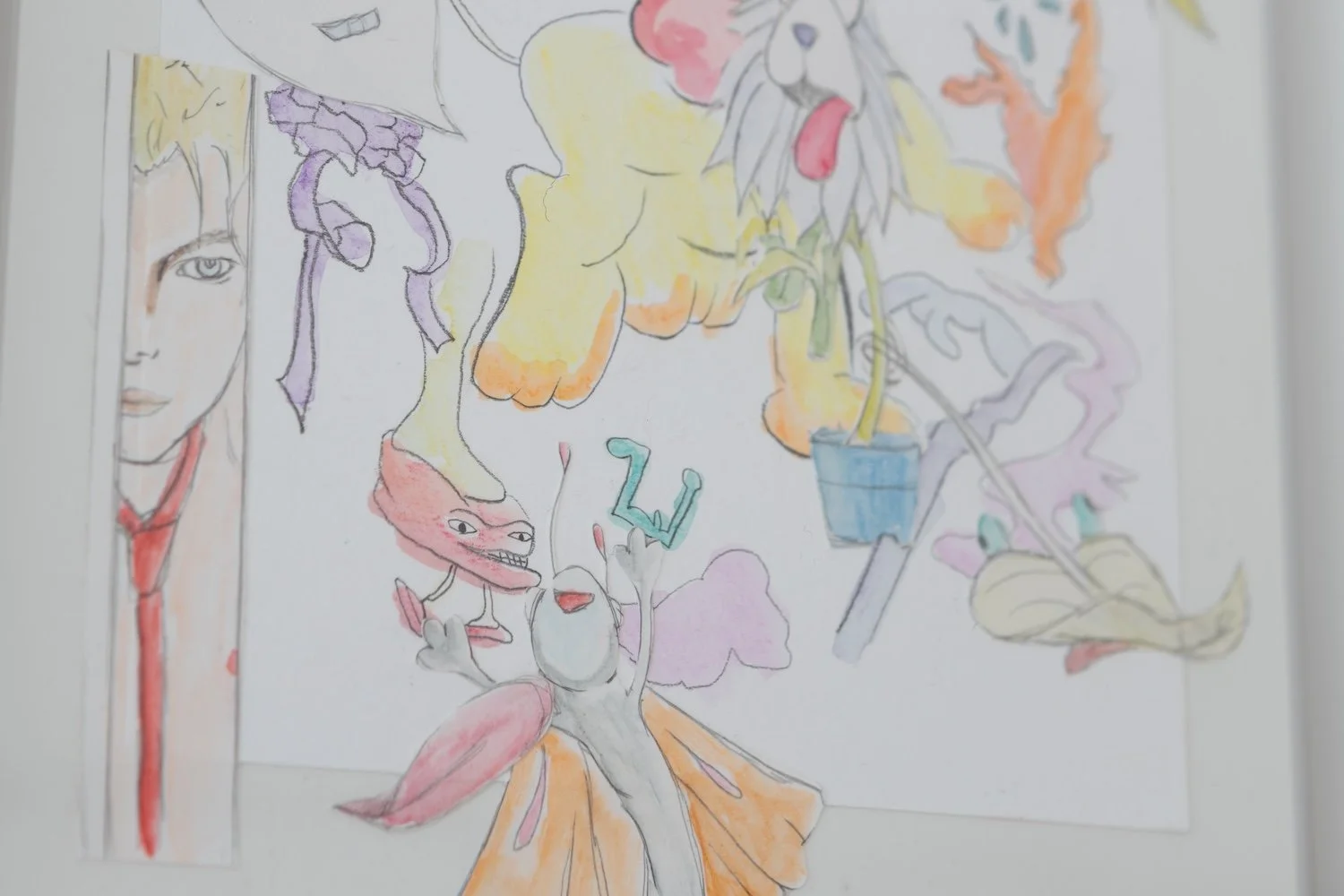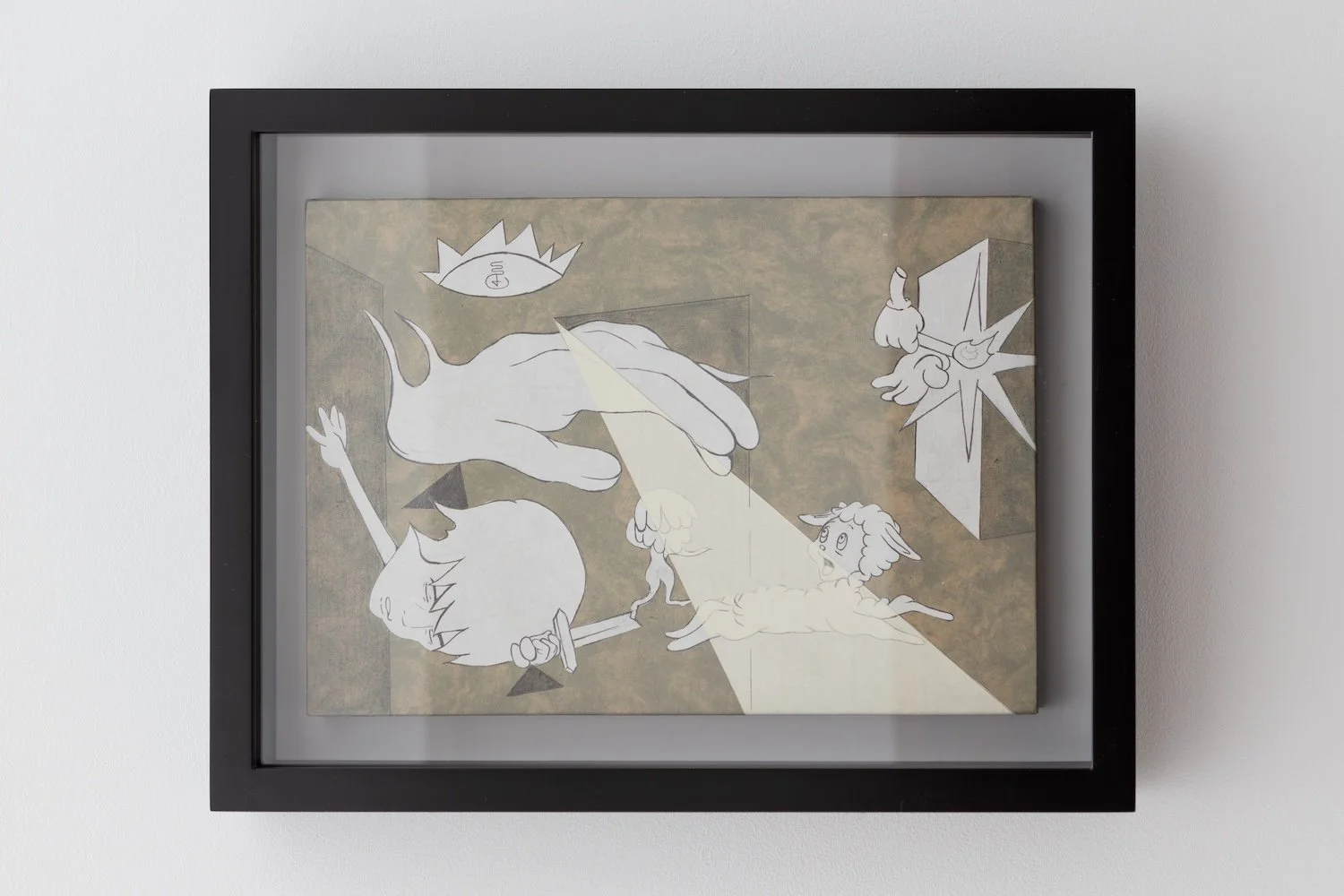Ochi Yasutaka “The school of flesh”
Ochi Yasutaka “The school of flesh”
越智康貴「肉体の學校」
2025年5月22日(木)― 6月8日(日)
越智康貴「肉体の學校」
このたび光灯では、越智康貴の個展「肉体の学校」を5月22日(木)より開催いたします。越智康貴は1989年生まれ。文化服装学院を卒業後、2011年にフラワーショップ〈DILIGENCE PARLOUR〉を開業。現在はフローリストのほか写真や文章の分野でも活躍しています。
数年前より絵画など作品の制作を本格的に始め、本展が初の個展となります。本展ではコラージュ、水彩、アクリルなどの新作約30点を発表します。
本展のタイトル「肉体の學校」は、三島由紀夫の同名小説から引用されたものですが、越智がステートメントで述べるように「肉体を学び、意識に主体性を取り戻す」という考えが込められています。
言い換えればそれは、社会の基準に偏った自己評価から距離を置き、「自分自身」の存在そのものに価値を見出す視点が重要なのだということを企図します。越智にとって作品とは、感情の発露である以上に、いまを生きる人々への静かな願いを込めた祈りでもあるのかもしれません。
作家・批評家のスーザン・ソンタグは「沈黙の美学」 (1967年)のなかで、
〈どの時代も「スピリチュアリティ」がめざすところをみずから再発明しなくてはならない。(スピリチュアリティ=人間の生に内在する苦しい構造的矛盾を解決し、人間意識の完成、つまりは超越をめざすための計画、用語、観念。)〉*
と述べ、そのもっとも有効なメタファーとしてアートがあると説いています。
花や言葉、占いを通して人と関わってきた越智にとっても、人間が根本的に持つ矛盾を解決することが、そのままアートという表現に結びついていったのも、自然なことと言えるでしょう。
越智の絵画には、サブカルチャーの雰囲気を帯びたキャラクター、臓器、花、自画像、友人のポートレート、ピカソらモダニズムの画家たちを彷彿させるイメージなど、夢や記憶の深層を旅するような図像が目まぐるしく登場します。
越智が既存のイメージの記憶から再構成したこれらのイメージコラージュと、「自分を主体的に感じ取ること」という制作のテーマとが結びつき、鑑賞者に対しても自身の記憶や感情を開き、内に抱える矛盾と向き合うきっかけを促しているかのようです。
本展「肉体の學校」では、越智が花や言葉を通して育んできたものの見方や世界との関わり方を基盤に、視覚芸術という新たな領域で、自らの思考と感覚を静かに掘り下げていきます。ぜひこの機会にご高覧ください。
*スーザン・ソンタグ.『ラディカルな意思のスタイルズ[完全版]』 河出書房新社, 2018, p.9(管啓次郎+波戸岡景太訳)
アーティスト・ステートメント
「自己肯定感」、「自分を大切に」、「人と比べない」、そんなセリフが聞こえてきます。その度に、その前段階のことを考えます。
心は見えない世界だと思われているけれど、“自分が主体”という世界観であれば、実際には心の方が見え(実際に知覚でき)、体の方は中途半端にしか見えていません(自分の顔も見えず、想像で補っています)。
一般常識で考えると、実際(心)と想像(肉体)は入れ替わっています。つまり、実際としての肉体に、想像としての心になってしまっています。
他者や社会という概念からの視点を中心にしているため、自分自身にとっても心というものは不可視に思えているのだと思います。
けれど自分が世界を見ている時、世界を見るという意識が働いている時には、世界が自分に意識を働かせています(世界=社会ではなくて、言葉通りの"世界")。
社会通念ももちろん大切で、実際に社会というものは存在しているけれど、自分より社会のほうが大きいという感じ方は、すでに古い考えになっているように思えます。
自分らしさを他人からの承認に求めるのではなくて、世界に向けて表現することが必要だと思えます。それによって世界が自分らしさを求めてくるからです。運動には相対性があり、観察されることによって初めて運動が認められるからであり、同時に、相対的な運動は交換可能だからです。
観察と運動は大切な概念です。万物を構成する素粒子は、内的な回転性を持っており、観測されるとき存在が確定します。つまり、物事を観察することによって、初めてその存在が現実のものとなります。
手のひらの上で独楽を回せば、独楽の360度全体が見えます。自分が回転すれば、世界が回ります。
運動は相対的なので、動いているものと止まっているものは交換可能です。
そして物事を観察する時、自身の意識は、観察している対象物の裏側の中心点にあります。
世界に対して運動する時、世界を観察する時、意識は世界の裏側の中心点にあります。
物理的な肉体とは無関係に。
肉体を学び、意識に主体性を取り戻すことを提案します。
概要
越智康貴「肉体の學校」
会場|光灯
会期|2025年5月22日(木)〜6月8日(日)
開廊時間|木・金 13:00〜19:00 土・日 12:00〜18:00[月火水 休]
住所|101-0037 東京都千代田区神田西福田町4-5 神田ビル3F
アクセス|神田駅、岩本町駅から徒歩5分、小伝馬町駅から徒歩6分
オープニングレセプション|5月22日(木)18:00〜20:00 どなた様もぜひお越しください。
-
Ochi Yasutaka “The school of flesh”
Born in 1989, Yasuki Ochi graduated from Bunka Fashion College and founded the flower shop DILIGENCE PARLOUR in 2011. In addition to his work as a florist, he is also active in photography and writing.
A few years ago, he began devoting himself to creating artworks, and for this exhibition, he will present approximately 25 new pieces including collages, watercolors, and acrylic works.
The exhibition title, School of the Flesh, is borrowed from the novel of the same name by Yukio Mishima. As Ochi notes in his statement, it expresses the idea of “learning through the body and reclaiming agency over one's consciousness.”
In other words, it suggests the importance of distancing oneself from self-evaluation skewed by societal norms and recognizing the inherent value of simply being oneself. For Ochi, creating art may be less an emotional outpouring than a quiet prayer—a hope directed at those living in the present.
In her 1967 essay The Aesthetics of Silence, writer and critic Susan Sontag wrote:
“Every era must reinvent for itself the project of spirituality—[that is,] the program, terms, and concepts aimed at resolving the painful structural contradictions inherent in human life and achieving the completion of consciousness, in other words, transcendence.”*
She argued that art is the most effective metaphor for this pursuit.
For Ochi, who has long engaged with others through flowers, words, and fortune-telling, it seems only natural that confronting the fundamental contradictions of human existence would evolve into an artistic practice.
In his paintings, characters tinged with subcultural aesthetics, internal organs, flowers, self-portraits, portraits of friends, and references to modernist artists like Picasso whirl across the surface like a journey through the layers of dreams and memory.
These collaged images, reconstructed from Ochi’s visual memory, are tightly interwoven with his creative theme of “perceiving oneself subjectively,” prompting viewers to open their own memories and emotions and confront the contradictions within.
In School of the Flesh, Ochi quietly delves into his thoughts and sensations through visual art—a new terrain for him—while drawing from the perspectives and ways of engaging with the world that he has cultivated through his work with flowers and words.
We invite you to experience this exhibition.
* Susan Sontag, Styles of Radical Will [Complete Edition], KawadeShoboShinsha, 2018, p. 9 (translated by Keijiro Suga and Keita Hatooka)
Artist Statement
Phrases such as “Boost self-esteem,” “Take care of yourself,” or “Don’t compare yourself to others” are commonly heard, but often, attention should be directed to what precedes these expressions—what must be understood first.
The mind is often thought of as invisible and abstract. However, adopting a worldview where the individual is the center of experience reveals that the mind feels more real and directly perceived than the body. After all, it is impossible to see one’s own face without a mirror. Much of the experience of the body is shaped by imagination.
In everyday thinking, roles have been reversed: the body is considered real, and the mind is treated as vague or imagined. This inversion occurs because individuals are accustomed to seeing themselves through the lens of others, through the collective gaze of “society.” As a result, even one’s inner life can seem hidden.
However, when the world is observed consciously, it engages with the observer. This world does not refer to society or social norms, but to the actual, physical, living world.
While society is significant and shapes lives, the old belief that society is more important than the self no longer seems fitting. The sense of self should not be reliant on external validation. Instead, the need is to express oneself to the world. When this happens, the world responds, as motion invites recognition.
Movement is inherently relative. It only becomes real when it is observed. What is moving and what is still can always be reversed, depending on the point of view.
At a fundamental level, all things are made of spinning particles. These particles do not fully “exist” until they are observed. In essence, things are born in the moment they are perceived.
When a top is spun in the hand, its full 360 degrees can be seen. However, when one spins instead, it is the world that appears to move. This is the relativity of motion: the moving and still are interchangeable.
When something is observed, awareness locates itself not on the surface but at the invisible center behind what is seen. Observing the world aligns consciousness with that central point, not physically, but perceptually.
This is why the study of the body is necessary—not to be controlled by it, but to reclaim the autonomy of awareness and return to the center of one’s own experience.
Exhibition Overview
Ochi Yasutaka “The school of flesh”
Venue|光灯 Kohtoh
Exhibition Day |May 22, 2025 – June 8, 2025
Opening Hours|Thu & Fri: 13:00–19:00 / Sat & Sun: 12:00–18:00
Opening Reception|May 22 18:00-20:00
Artist Profile
越智康貴 Ochi Yasutaka
1989年生まれ。花や文章、写真、絵など様々な方法で表現活動を行う。
Born in 1989, he explores creative expression through a variety of media such as flowers, writing, photography, and painting.
Instagram @ochiyasutaka
Photo by Kohey Kanno







